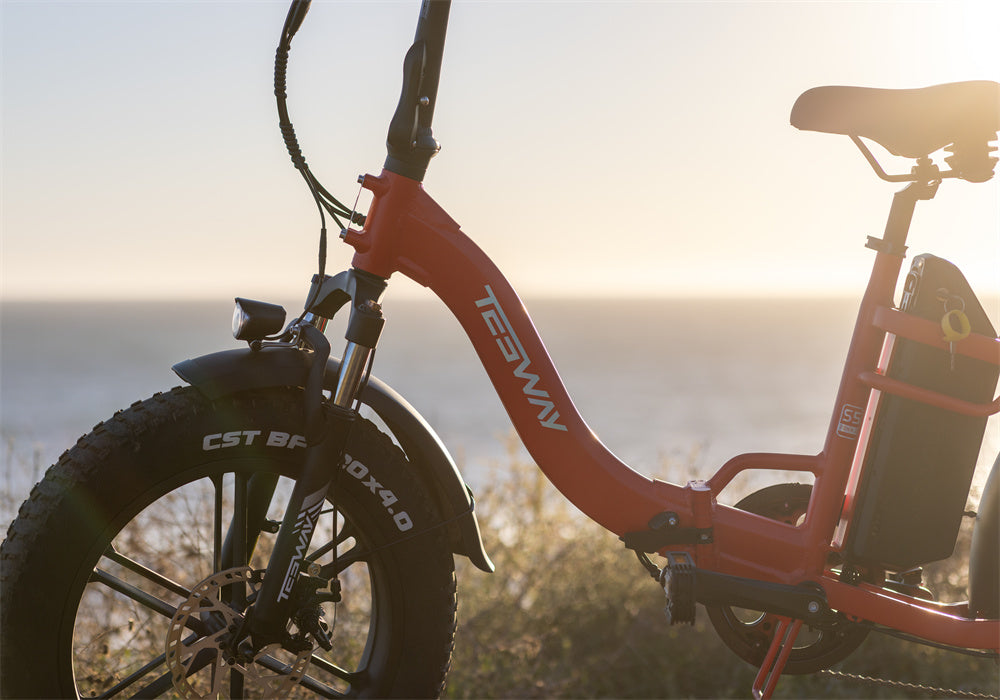Maintaining the performance of your electric bike involves regular attention to key components, and the rear derailleur is no exception.
Proper adjustment of the rear derailleur ensures smooth, reliable shifting, which is essential for both efficiency and enjoyment.
In this guide, we’ll cover the full process of adjusting the rear derailleur on your e-bike to keep it running at its best.
🔥Here are more guides maintanence of electric bike:
Easy Steps to Remove Speed Limiter On Electric Bike
Lost Your E-Bike Key? Here's How to Replace Your Battery Lock
Why Proper Rear Derailleur Adjustment is Essential
The rear derailleur controls the shifting of gears on your e-bike’s cassette, allowing you to change gears for different speeds and terrain. If your derailleur is not adjusted correctly, it can lead to:
-
Chain skipping or slipping during gear changes.
-
Inconsistent shifting that interrupts your ride.
-
Wear and tear on both the derailleur and the cassette.
Regular adjustments and tuning not only help your e-bike ride smoothly but also extend the lifespan of these essential components.
Tools You’ll Need
Before starting the adjustment, gather the following essential tools:
-
Phillips or flat-head screwdriver (for adjusting limit screws)
-
Allen wrench set (usually 5mm for most derailleur bolts)
-
Bike stand (optional but helpful for better access)
-
Cleaning rag or brush (to clean the derailleur and chain)
Having these tools on hand will make the adjustment process smoother and more precise.
SEE ALSO Struggling with a Stuck E-Bike Battery? 6 Easy Ways to Remove It!

How to Adjust the Rear Derailleur
Step 1: Position the Bike for Optimal Access
Secure your e-bike on a bike stand to lift the rear wheel.
This setup makes it easier to work with the derailleur and allows you to turn the pedals freely without obstruction.
If you don’t have a bike stand, you can turn the e-bike upside down, resting it on the seat and handlebars.
Step 2: Check the Derailleur Alignment
Inspect the derailleur hanger—the metal piece connecting the derailleur to the bike frame. If the hanger is bent or misaligned, the derailleur won’t shift properly, even with careful adjustment. To check alignment:
Look at the derailleur from behind and make sure it is parallel with the cassette.
If the hanger is bent, use a derailleur alignment tool or have it fixed by a professional.
Step 3: Adjust Cable Tension
Cable tension plays a significant role in precise shifting. To adjust it:
-
Shift to the smallest cog (highest gear).
-
Locate the barrel adjuster near the shifter or at the derailleur. This adjuster fine-tunes cable tension.
-
If shifting feels sluggish, turn the barrel adjuster counterclockwise to increase tension. For overshooting gears, turn it clockwise to reduce tension.
Test by shifting through gears. If shifting doesn’t improve, adjust the cable tension slightly until you reach a smooth result.
Step 4: Set the Limit Screws (High and Low Limits)
The limit screws control the derailleur's range of motion, preventing the chain from falling off the cassette. The high limit screw (marked “H”) limits the movement towards the smallest cog, while the low limit screw (marked “L”) controls the largest cog.
Setting the High Limit
-
Shift to the smallest rear cog.
-
Turn the high limit screw until the upper derailleur pulley aligns perfectly with the smallest cog.
-
Adjust until the chain moves smoothly without skipping.
Setting the Low Limit
-
Shift to the largest rear cog.
-
Adjust the low limit screw to align the upper derailleur pulley with the largest cog.
-
Ensure there’s no chain rubbing or excess noise.
Adjust both limit screws carefully, as improper settings can lead to the chain falling off the cassette during shifts.
Step 5: Fine-Tune the B-Screw
The B-screw controls the gap between the upper derailleur pulley and the largest cog. This gap should be minimal but not so close that it interferes with the chain. Adjusting the B-screw ensures smoother shifting across gears, especially when moving into larger cogs.
-
Shift to the largest rear cog.
-
Locate the B-screw (usually at the top of the derailleur).
-
Turn the B-screw until the upper pulley is about 5-6 mm away from the largest cog.
Proper B-screw adjustment prevents the derailleur from rubbing against the cassette and ensures smooth performance in all gears.
Testing Your Rear Derailleur Adjustment
After adjusting all the components, it’s crucial to test the performance:
-
Shift through all gears, from the smallest to the largest cog.
-
Listen for any unusual noises, and feel for smooth transitions.
-
If there is any skipping, return to the barrel adjuster to make minor tweaks to the cable tension.
Repeat this process as necessary until shifting is consistently smooth in every gear.
Troubleshooting Common Rear Derailleur Issues
Even with careful adjustment, some issues may persist. Here are solutions for common problems:
Chain Skipping Between Gears
If the chain skips during shifts:
-
Recheck cable tension and adjust the barrel as needed.
-
Ensure the high and low limit screws are correctly aligned with the smallest and largest cogs.
Inconsistent Shifting
If shifting feels imprecise:
-
Inspect for a frayed or dirty cable. Cleaning and lubricating the cable can improve tension.
-
Check the derailleur hanger alignment, as a bent hanger will hinder smooth shifting.
Chain Falling Off the Cassette
If the chain falls off the cassette, either toward the frame or outward:
Reexamine the high and low limit screws. Over-tightening or loosening can cause the derailleur to shift too far.
If these issues persist, consider consulting a professional for more precise adjustments.
Maintenance Tips
Regular maintenance of the rear derailleur will keep it in peak condition, extending its life and enhancing the overall performance of your e-bike. Here are some best practices:
Clean and Lubricate: Regularly clean the derailleur with a rag or brush to remove dirt and debris. Lubricate the chain and pivot points to prevent rust.
Inspect Cable Tension: Over time, cables may stretch, affecting derailleur performance. Check cable tension regularly and adjust as needed.
Routine Adjustment: Periodically check limit screws and B-screw adjustments to prevent wear.
A well-maintained derailleur ensures your e-bike performs at its best, delivering a smooth, hassle-free ride.
Conclusion
Adjusting the rear derailleur on an e-bike may seem complex, but with careful attention to detail, the right tools, and patience, it becomes manageable.
Taking the time to correctly adjust and maintain this critical component will enhance your riding experience, prevent mechanical issues, and extend the lifespan of your e-bike’s drivetrain.
Following these steps and maintaining regular adjustments will keep your e-bike shifting smoothly and reliably on every ride.
FAQs
How often should I adjust my rear derailleur?
Adjustments depend on how often you ride, but it's recommended to check your derailleur every few months, especially if you experience shifting issues.
What if my derailleur hanger is bent?
A bent hanger can cause alignment problems, so it’s best to fix or replace it immediately. Many bike shops offer derailleur hanger alignment as a quick service.
Can I adjust the rear derailleur without a bike stand?
Yes, although a bike stand offers easier access. You can turn your bike upside down or have someone help hold it steady while you make adjustments.







Share:
Halloween Spooktacular: Tesway’s Best E-Bike Deals – One Day Only!
How to Fix an E-Bike Not Working After Rain